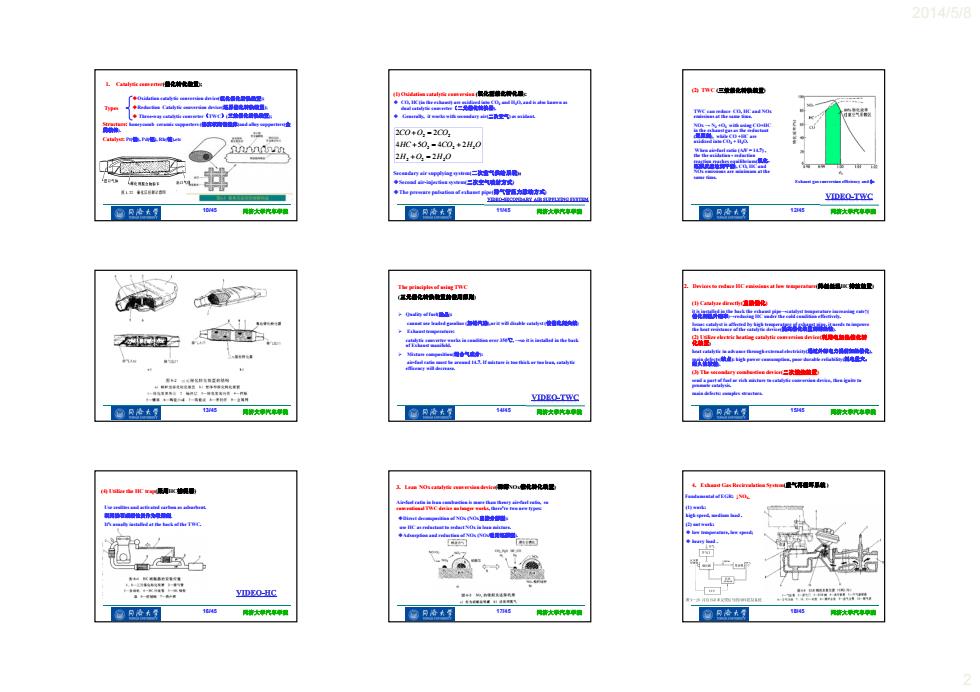正在加载图片...

201458 L.C4aen色t量 西TC三辣业北州推教量 卡heCb面ad■h-笔银花减 ◆岂nah加a 白w小通通 2C0+0.-200 之号:地出 把 01110 4H+50,=4C0+2H,0 2H,+0-2H,0 w ainfal an. eau山的山ae小e击二收童气转最 华国的w巴家空气时家 4拉组形能( “ VIDEO-TWC @R冷大? 1w45 窗凡冷法复 降情大带汽单物 窗凡冷复 1345 清大汽 The priadiplos of arlng TWC 范儿化特的列 Cae4w南化 宁出安2 smme tto badid gioen将线国色akb caldlyu教t处的铺 VIDEOLTWC @R冷法习 134s 1445 45 4E山aC山as气厚M) 蜂山E到K果量子 Fesdomtd afE Ml 到推具作为绿额 .B w Ie atrdutagte adat-NOs is ah nats VIDEO-HC 重4气特银我法等养年 4小4814四 包R冷法? 14g 骨清大草究部单酒 位只冷大T 1用5 窗R冷大 阳疹大汽2014/5/8 2 10/45 同济大学汽车学院 Types Oxidation catalytic conversion device(氧化催化转换装置); Reduction Catalytic conversion device(还原催化转换装置); Three-way catalytic converter(TWC)(三效催化转换装置); 1. Catalytic converter(催化转化装置); Structure: honeycomb ceramic supporters (蜂窝状陶瓷载体)and alloy supporters(金 属载体). Catalyst: Pt(铂), Pd(钯), Rh(铑).etc 11/45 同济大学汽车学院 (1) Oxidation catalytic conversion (氧化型催化转化器): CO, HC(in the exhaust) are oxidized into CO2 and H2O, and is also known as dual catalytic converter(二元催化转换器). Generally, it works with secondary air(二次空气) as oxidant. H O H O HC O CO H O CO O CO 2 2 2 2 2 2 2 2 2 2 4 5 4 2 2 2 Secondary air supplying system(二次空气供给系统): Second air-injection system(二次空气喷射方式) The pressure pulsation of exhaust pipe(排气管压力脉动方式) 12/45 同济大学汽车学院 (2) TWC (三效催化转换装置) TWC can reduce CO, HC and NOx emissions at the same time. NOx → N2 +O2 with using CO+HC in the exhaust gas as the reductant (还原剂), while CO +HC are oxidized into CO2 + H2O. When air-fuel ratio (A/F = 14.7) , the the oxidation - reduction reaction reaches equilibrium(氧化- 还原反应达到平衡), CO, HC and NOx emissions are minimum at the same time. Exhaust gas conversion efficiency and a 13/45 同济大学汽车学院 14/45 同济大学汽车学院 The principles of using TWC (三元催化转换装置的使用原则) Quality of fuel(油品): cannot use leaded gasoline (加铅汽油),or it will disable catalyst (使催化剂失效) Exhaust temperature: catalytic converter works in condition over 350℃, →so it is installed in the back of Exhaust manifold. Mixture composition(混合气成分): air-fuel ratio must be around 14.7. If mixture is too thick or too lean, catalytic efficency will decrease. 15/45 同济大学汽车学院 2. Devices to reduce HC emissions at low temperature(降低低温HC排放装置) (1) Catalyze directly(直接催化) it is installed in the back the exhaust pipe→catalyst temperature increasing rate↑( 催化剂温升速率)→reducing HC under the cold condition effectively. Issue: catalyst is affected by high temperature of exhaust pipe, it needs to improve the heat resistance of the catalytic device(提高催化装置的耐热性). (2) Utilize electric heating catalytic conversion device(利用电加热催化转 化装置) heat catalytic in advance through external electricity(通过外部电力提前加热催化), main defects(缺点): high power consumption, poor durable reliability(耗电量大, 耐久性较差). (3) The secondary combustion device(二次燃烧装置) send a part of fuel or rich mixture to catalytic conversion device, then ignite to promote catalysis. main defects: complex structure. 16/45 同济大学汽车学院 (4) Utilize the HC trap(采用HC捕捉器) Use zeolites and activated carbon as adsorbent. 利用沸石或活性炭作为吸附剂. It’s usually installed at the back of the TWC. 17/45 同济大学汽车学院 3. Lean NOx catalytic conversion device(稀薄NOx催化转化装置) Air-fuel ratio in lean combustion is more than theory air-fuel ratio, so conventional TWC device no longer works, there’re two new types: Direct decomposition of NOx (NOx直接分解型): use HC as reductant to reduct NOx in lean mixture. Adsorption and reduction of NOx (NOx吸附还原型). 18/45 同济大学汽车学院 Fundamental of EGR: ↓NOX. (1) work: high speed, medium load . (2) not work: low temperature, low speed; heavy load . 4. Exhaust Gas Recirculation System(废气再循环系统 )